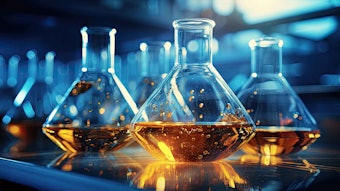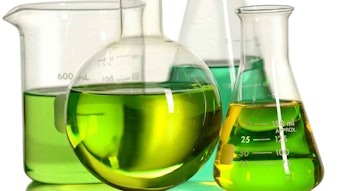Polydimethylsiloxane (PDMS), more commonly known as dimethicone, is the most widely utilized silicone material in cosmetics and personal care.1, 2 It is found in a wide variety of rinse-off and leave-on products such as shampoos, hair conditioners, skin moisturizers and color cosmetics.3, 4 Despite its relatively simple chemical structure, dimethicone exhibits unique physical properties that render it effective for conditioning and protecting the hair and skin, and improving the sensorial attributes of formulations. Dimethicone is also a key component of hundreds of modified silicones, which represent some of the most sophisticated and high performance ingredients available today.
Chemistry
Dimethiconem shown in Figure 1">Figure 1, is a hybrid inorganic-organic homopolymer comprised of dimethylsiloxane repeat units, i.e., the polymer consists of an inorganic siloxane backbone (–Si–O–) that bears two methyl (–CH3) groups on each silicon (Si) atom. According to the International Cosmetic Ingredient Dictionary & Handbook, the name dimethicone refers specifically to fully methylated PDMS homopolymers that are end-capped with trimethylsiloxy (TMS) groups.3 Other International Nomenclature of Cosmetic Ingredients (INCI) names are used to refer to PDMS homopolymers with different end-groups. For example, hydroxyl (–OH) end-capped PDMS is called dimethiconol, and hydrogen end-capped PDMS is called bis-hydrogen dimethicone. The degree of polymerization (DP), i.e., the value of n in Figure 1">Figure 1, can span several orders of magnitude for dimethicone. Thus, n can be as low as 0–3 for the volatile silicones, to as high as several thousand for high viscosity silicone gums.1 Note that when n = 0 and n = 1, the INCI names for the compounds are disiloxane and trisiloxane, respectively.
he unique physical properties of dimethicone are due to molecular level features that distinguish it from organic polymers such as polymers with carbon -based backbones.1, 5 Si atoms have larger atomic radii and are less electro- negative than C atoms, making the O–Si–O bond lengths and bond angles of dimethicone longer and larger, respectively, compared to the C–C or C–O–C bonds found in most organic polymer backbones. The atomic properties of Si also contribute to greater degrees of rotational freedom for the CH3 groups and around the Si–O bonds. These molecular characteristics lead to significantly weaker intermolecular attractive forces in dimethicone, rendering it a highly flexible, nonpolar polymer with an extended conformation and a large excluded or “free” volume between polymer chains in the bulk state. A notable consequence of this greater chain mobility is that dimethicone polymers with high degrees of polymerization remain fluid in the bulk state, whereas organic polymers at identical degrees of polymerization such as polyethylene, polypropylene or polyethylene oxide exist as solids in the bulk state.
Manufacture
The key feedstocks for the manufacture of dimethicone are Si metal and methyl chloride (CH3Cl), an organic intermediate derived from the reaction of methanol and hydrochloric acid (HCl).5, 6 Si metal is obtained from mineral quartz, a naturally occurring crystalline form of silicon dioxide (SiO2), by a process known as carbothermic reduction, as shown in Figure 2">Figure 2a. In this reaction, quartz sand is mixed with coke (carbon) and then heated to extremely high temperatures (1,700°C) to yield relatively pure Si metal with CO2 as a by-product.
Direct process: Si metal is converted to methylchlorosilanes through its reaction with methyl chloride (CH3Cl) using the direct process, also known as the Rochow process for its inventor Eugene G. Rochow.2, 5 In this process, shown in Figure 2">Figure 2b , CH3Cl is reacted with a mixture of Si metal powder and a copper (Cu) catalyst in a fluidized bed reactor at 250–300°C. The Cu catalyst system typically contains traces of other metals such as zinc or tin as catalyst promoters that enhance reactivity and selectivity of the catalyst for specific methylchlorosilanes. The reactor product is a mixture of methylchlorosilanes that are separated and purified via distillation.
Dimethyldichlorosilane (DMDCS), the critical intermediate required for the synthesis of PDMS, is the primary product of the direct process. The other methylchlorosilane products, such as methyltrichlorosilane and trimethylchlorosilane, are employed in the synthesis of other silicone-based chemicals and polymers.
Hydrolysis: The next step in PDMS synthesis, shown in Figure 3">Figure 3, is the hydrolysis of DMDCS to produce a mixture of cyclic and linear silanol-terminated, i.e., OH-terminated, PDMS oligomers that are referred to as hydrolysate.2, 6 The hydrolysis is typically conducted by feeding DMDCS and aqueous HCl into a continuous reactor that produces the hydrolysate and a more concentrated HCl solution as a by-product. The hydrolysate is separated from the concentrated HCl upon exiting the reactor. A fraction of anhydrous HCl is recovered and reused to synthesize more CH3Cl for use in the direct process, while the remaining aqueous HCl is recycled back into the reactor. The hydrolysate is washed to remove residual acid, neutralized, dried and filtered. Hydrolysate contains approximately 35–50% cyclic PDMS oligomers, with the cyclic tetramer (D4, INCI: Cyclotetrasiloxane) and cyclic pentamer (D5, INCI: Cyclotetrasiloxane) comprising the majority of the cyclic fraction. Hydrolysate is further refined via distillation to isolate the various linear and cyclic components, which may be used as-is or as precursors to silicone materials. For example, the D4 and D5 cyclic oligomers are the primary components of many cyclomethicone fluids that are used as cosmetic ingredients, yet the D4 is also employed as a “monomer” in the synthesis of dimethicone via ring-opening polymerization.2
Polymerization: PDMS is readily synthesized from the various hydrolysate components by a diverse selection of techniques employing a broad range of possible reaction conditions and catalysts.1, 5, 7, 8 The primary route for the commercial scale synthesis of dimethicone is the ring-opening polymerization of the D4 cyclic oligomer, as shown in Figure 4">Figure 4, which may be carried out in batch or continuous processes. D4 undergoes equilibrium polymerization in the presence of acid or base catalysts to produce a mixture of high molecular weight (MW) polymers and mixed cyclic oligomers. Examples of catalysts include acidified montmorillonite, sulfuric acid on carbon, or potassium hydroxide. The equilibrium reaction favors polymer formation due to the increase in entropy that occurs when the cyclic oligomers are converted to linear polymer. MW control is achieved by the addition of trimethylsilyl functional compounds, which act as chain stoppers to end-cap the PDMS. For example, in the reaction shown in Figure 4">Figure 4, the degree of polymerization, and thus the MW, of the resulting dimethicone would be dictated by the ratio of HMDS to D4 in the reaction mixture.
Alternatively, dimethicone can be produced by the condensation polymerization of the linear silanol-terminated oligomers from the hydrolysate, as shown in Figure 5">Figure 5.5, 7 The reaction is typically catalyzed by strong bases, such as potassium silanoate or tetramethylammonium hydroxide, but it may also be catalyzed by strong acids. To obtain high MW PDMS, the polymerization reaction must be driven by heating and removal of water under vacuum conditions. As the product of the condensation reaction is OH-terminated dimethiconol, the resulting polymer must be end-capped by reaction with a trimethylsilyl reagent, such as trimethylchlorosilane, to produce the TMS-terminated PDMS that conforms to the INCI definition of dimethicone.
Upon completion of the polymerization reactions to produce dimethicone, the catalysts are removed from the dimethicone product by neutralization and/or filtration, and the product is vacuum-stripped to remove residual low MW linear and cyclic oligomers. Catalyst removal is critical to ensuring the stability of the final products, as catalyst residues readily promote depolymerization of dimethicone, particularly at elevated temperatures and in the presence of ambient water.7 To overcome the necessity for stringent catalyst removal, commercial polymerization processes employ transient catalysts that can be thermally inactivated at the end of the polymerization reaction to prevent catalysis of depolymerization; examples include tetrabutylphosphonium hydroxide and tetramethylammonium silanoate.5, 7, 8
Properties
Dimethicone is typically supplied as a colorless, odorless, oil-like fluid with a viscosity from 1–1,000,000 centistokes (cSt), although the most commonly employed grades tend to have viscosities of 100–300,000 cSt.1, 2 Although the silicone industry uses the cSt convention, most formulators are accustomed to seeing viscosity values reported in units of centipoise (cP) (see Centipoise [cP] vs. Centistokes [cSt]). The viscosity of the dimethicone is related to the MW and polydispersity of the polymer, and fluids of different viscosities may be obtained by either controlling the MW during polymerization or by blending dimethicone polymers of different MWs to achieve the desired viscosity. Unlike hydrocarbon oils and polymers, dimethicone fluids exhibit little change in viscosity as a function of temperature. Low MW dimethicones are Newtonian fluids, yet dimethicone will begin to exhibit non-Newtonian flow behavior when MW values exceed 35,000 g/mol.5
Dimethicone is less dense than water, with densities at 25°C ranging from 0.82 g·cm-3 for a one cSt fluid to 0.98 g·cm-3 for a 1,000,000 cSt fluid.9–11 The density of dimethicone increases with increasing MW of the polymer due to the decreasing number of chain ends in the bulk material as the DP increases, which leads to decreased chain mobility and less free volume in the material. Dimethicone fluids with viscosities less than 10 cSt, i.e., with DP values < 15 repeat units, are volatile, although the volatility rapidly decreases as a function of increasing MW.1 Low MW volatile dimethicones are routinely added to high viscosity dimethicone gums to modify their flow properties.10
Dimethicone is a hydrophobic polymer that exhibits MW-dependent solubility, with low MW dimethicones being compatible with a broader range of solvents. Dimethicone is insoluble in water and polar organic solvents such as propylene glycol and glycerin. Low viscosity dimethicones, e.g., < 5 cSt, can be dissolved in certain polar organic solvents, including ethanol and isopropanol. Higher viscosity dimethicones are less tolerant of solvent polarity, yet they are generally soluble in a variety of nonpolar organic solvents including hydrocarbons, ethers, esters and ketones.1, 11
Due to its weak intermolecular attractive forces, dimethicone exhibits low surface energy and high gas diffusivity coefficients. These features enable it to easily spread into thin, uniform, water-repellent films that are highly permeable to gases such as oxygen, carbon dioxide and water vapor.1, 5
Dimethicone is recognized as being nontoxic and safe for use in cosmetic, medical/pharmaceutical and food contact applications.4 Possible impurities in dimethicone fluids can include low levels (< 1%) of cyclic oligomers, e.g., D4/D5, and trace levels (< 5 ppm) of heavy metals. As an anhydrous polymer, dimethicone does not require preservation when supplied in bulk form. It is a relatively inert material, although it is readily attacked and degraded by strong acids and bases.1 Dimethicone is not biodegradable; however, it undergoes gradual chemical degradation in the environment to yield SiO2, H2O and CO2 as degradation products.
Applications
Dimethicone has a myriad of applications in cosmetics and personal care products.1–4 In addition to skin and hair care applications, it is an important ingredient in the formulation of antiperspirants/deodorants; color cosmetics; shaving preparations; and anhydrous, condom-compatible personal lubricants. It is a popular conditioning agent due to its exceptional substantivity and distinct feel.1, 2 The substantivity of dimethicone is driven by its low surface energy and high coefficient of spreading, which enable it to efficiently wet the skin and hair and coat it with thin, cohesive films that adhere well to these substrates.
For hair care applications, dimethicone may be added to shampoos, conditioners (rinse-off and leave-in), and styling products. It provides a variety of benefits including improved shine, lubricity (for comb force reduction) and reduced triboelectric charging to minimize static flyaway. In creams and lotions for skin care, dimethicone serves to improve feel, provide lubricity and softness, reduce tackiness and eliminate the whitening or “soaping” effect that can occur during rubout of the product. Typical usage levels in skin care emulsions are 0.1–2.0% w/w. High viscosity dimethicones have an oilier feel on the skin, with the feel becoming less oily and drier as the viscosity decreases.
Dimethicone may also be used as a skin protectant due to its ability to form breathable protective films that are comfortable on the skin. In the United States, the OTC monograph for skin protectant drug products permits usage of dimethicone as an active ingredient at 1–30 %.12 In addition to skin protecting moisturizers, other skin protectant applications include diaper rash creams and ointments, cold sore treatments and anti-chafing balms. For use in OTC drug applications, dimethicone must meet the requirements for Dimethicone NF as specified by the USP/NF monograph.9
The author would like to thank silicone expert Michael Starch of Wintermute Consulting Services for reviewing this manuscript and providing constructive feedback.
References
- MD Berthiaume, Silicones in cosmetics, ch 7 in Principles of Polymer Science & Technology in Cosmetics and Personal Care, ED Goddard and JV Gruber, eds, Marcel Dekker Inc, New York, USA (1999) pp 275–324
- AJ O’Lenick, Silicones for Personal Care, Allured Publishing Corp, Carol Stream, IL USA (2003)
- Dimethicone, Monograph ID 840, in the International Cosmetic Ingredient Dictionary and Handbook, 13th edn, Personal Care Products Council, Washington, DC USA (2010)
- FA Andersen, Final report on the safety assessment of stearoxy dimethicone, dimethicone, methicone, amino bispropyl dimethicone, aminopropyl dimethicone, amodimethicone, amodimethicone hydroxystearate, behenoxy dimethicone, C24-28 alkyl methicone, C30-45 alkyl methicone, C30-45 alkyl dimethicone, cetearyl methicone, cetyl dimethicone, dimethoxysilyl ethylenediaminopropyl dimethicone, hexyl methicone, hydroxypropyldimethicone, stearamidopropyl dimethicone, stearyl dimethicone, stearyl methicone, and vinyldimethicone, Int J Toxicol 22 (suppl. 2) 11–35 (2003)
- M Butts et al, Silicones, in Kirk-Othmer Encyclopedia of Chemical Technology, John Wiley & Sons, available at http://onlinelibrary.wiley.com/book/10.1002/0471238961 (Dec 20, 2002) pp 1–89 (Accessed Feb 21, 2012)
- HA Wittcoff, BG Reuben and JS Plotkin, Chemicals from methane, ch 10 in Industrial Organic Chemicals, John Wiley & Sons Inc, Hoboken, NJ USA (2004) pp 338–336
- A Colas and J Curtis, Silicone biomaterials: History and chemistry, in Biomaterials Science, An Introduction to Materials in Medicine, 2nd edn, BD Ratner, AS Hoffman, FJ Schoen and JE Lemons, eds, Elsevier Inc, New York, USA (2004) pp 80–86
- N Kirk, A continuous process for making silicones, Ind Eng Chem 51(4) 515–518 (1959)
- Dimethicone, Official monograph, in the United States Pharmacopeia 34–National Formulary 29, United Book Press Inc: Baltimore, USA (2011) pp 1517–1518
- Dow Corning Healthcare Product Selection Guide, Dow Corning Bulletin 51-988D-01, Dow Corning Corp, Midland, MI USA (2007)
- Silicone Products for Personal Care, Shin-Etsu Silicones of America Inc, Akron, OH USA (Sep 2010)
- Skin protectant drug products for over-the-counter human use; Final monograph; Final rule, Fed Regist 68(107) 33362-33381 (Jun 4, 2003)










